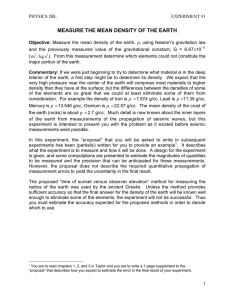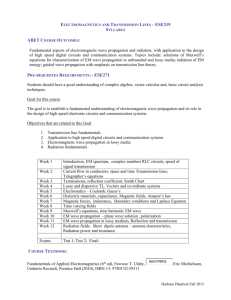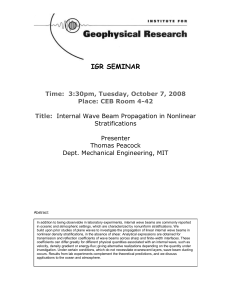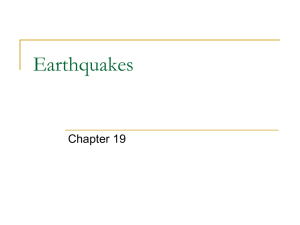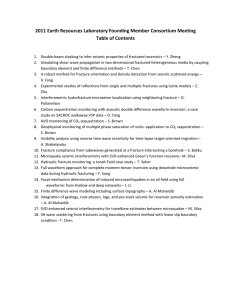RESERVOIR DELINEATION RESEARCH Richard L. Gibson, Jr.
advertisement
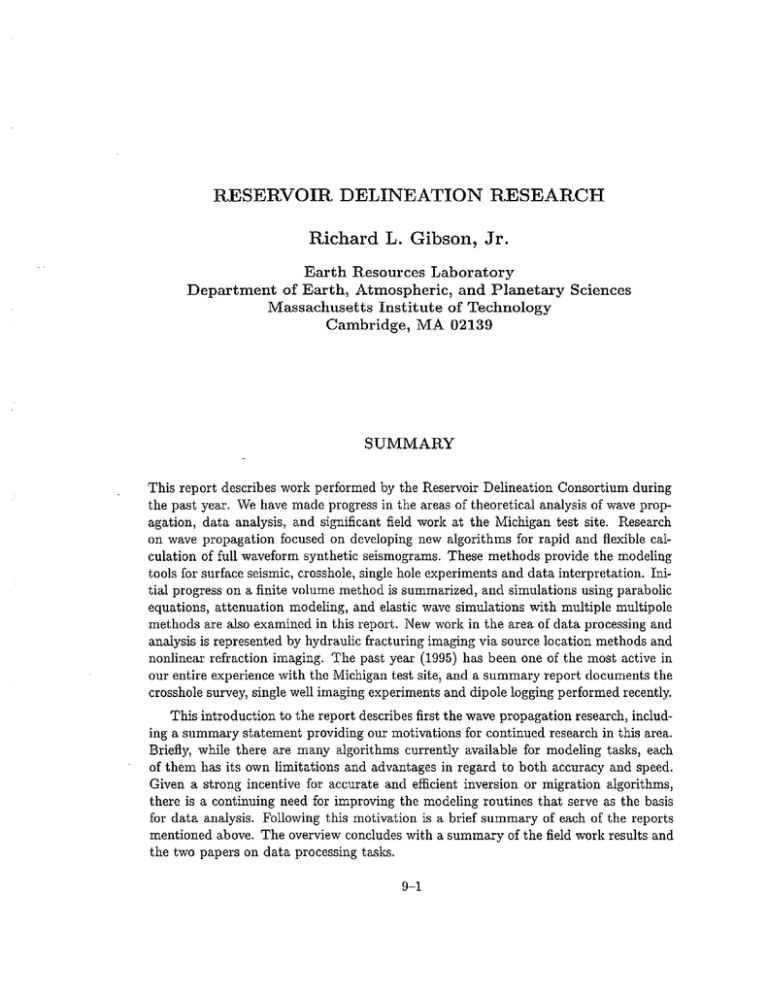
RESERVOIR DELINEATION RESEARCH Richard L. Gibson, Jr. Earth Resources Laboratory Department of Earth, Atmospheric, and Planetary Sciences Massachusetts Institute of Technology Cambridge, MA 02139 SUMMARY This report describes work performed by the Reservoir Delineation Consortium during the past year. We have made progress in the areas of theoretical analysis of wave propagation, data analysis, and significant field work at the Michigan test site. Research on wave propagation focused on developing new algorithms for rapid and flexible calculation of full waveform synthetic seismograms. These methods provide the modeling tools for surface seismic, crosshole, single hole experiments and data interpretation. Initial progress on a finite volume method is summarized, and simulations using parabolic equations, attenuation modeling, and elastic wave simulations with multiple multipole methods are also examined in this report. New work in the area of data processing and analysis is represented by hydraulic fracturing imaging via source location methods and nonlinear refraction imaging. The past year (1995) has been one of the most active in our entire experience with the Michigan test site, and a summary report documents the crosshole survey, single well imaging experiments and dipole logging performed recently. This introduction to the report describes first the wave propagation research, including a summary statement providing our motivations for continued research in this area. Briefly, while there are many algorithms currently available for modeling tasks, each of them has its own limitations and advantages in regard to both accuracy and speed. Given a strong incentive for accurate and efficient inversion or migration algorithms, there is a continuing need for improving the modeling routines that serve as the basis for data analysis. Following this motivation is a brief summary of each of the reports mentioned above. The overview concludes with a summary of the field work results and the two papers on data processing tasks. 9-1 Gibson INVESTIGATIONS IN SEISMIC WAVE PROPAGATION Motivations for Modeling Simulation of elastic wave propagation has several important applications. Forward modeling of seismograms for an earth model can help to confirm the accuracy, or possibly the inaccuracy, of the proposed velocity structure. Perhaps a more common use, however, is to utilize the propagation model as the basis for inference of a geological model from the seismic data itself. The various methods of migration and inversion all utilize some model of wave propagation to back propagate data into the subsurface or to derive corrections to earth models by computing errors based on differences between computed and observed seismograms. . While modeling capabilities in academia and industry have become increasingly powerful and more complex in recent years, so has the data that drives the numerical work come to originate from bigger and more sophisticated experiments. Three-dimensional surveys are increasingly the norm for exploration and production geophysics, and, with the quality and volume of data increasing, the interpretations have become increasingly more precise, focusing on more subtle features within the data. The utility of 3-D seismic has been shown for Gulf of Mexico reservoirs by Abriel et al. (1991), who present case histories showing that high quality 3-D acquisition and processing facilitate the identification of both structural and stratigraphic traps. In some cases, the 3-D data allows the identification of productive reservoirs that are completely missed in 2-D exploration (Abriel and Wright, 1991). Other applications of 3-D data include reservoir monitoring during steam floods, where velocity changes created by the advancing steam front can be tracked in detail in 3-D (Lumley, 1995). Tasks such as these examples entailing a very detailed interpretation of the data require careful analysis and processing-this is especially important in 3-D applications, where detailed, accurate simulations are still most difficult. They are also quite time-consuming, rendering many forms of analysis impractical. Therefore, there is still a need to improve our modeling capabilities for 3-D seismic wave propagation to facilitate robust, efficient and accurate analysis of such data. Below, I first discuss the range of methods often used in current research and applications. These approaches are in various stages of development and utility, and there may be gaps in the list. However, the principal algorithms used are discussed in increasing order of accuracy, and, not coincidentally, of increasing computer time. This survey of algorithms also outlines the shortcomings of each method. I then describe the papers in this volume that represent the current Earth Resources Laboratory research motivated primarily to overcome the limitations of methods described in the first part of this note. Existing Methods A number of approaches exist for the computation of synthetic seismograms, with varying degrees of applicability and accuracy. The variation in accuracy arises in part from 9-2 Reservoir Delineation Research the amount of analytic work done to simplify the equations describing wave propagation. For example, the ray method (Cerveny, 1985; Ben-Menahem and Beydoun, 1985; Gibson et al., 1991) applies a high frequency, asymptotic solution to the wave equation to derive a set of first order differential equations that can be integrated for ray paths, traveltimes and amplitudes. By performing a significant amount of mathematical analysis before approaching the computer, the geophysicist is able to achieve significant savings in computer time. One cost, however, is that programming becomes more challenging, because the code must be sufficiently complex to keep track of the location of a given ray path within the earth model and to know whether the ray should reflect or transmit on striking an interface within the modeL Additional difficulties arise in anisotropic media, where the two quasi-shear waves propagating through a general, anisotropic layer can be coupled in ways not accounted for in standard ray algorithms (Chapman and Shearer, 1989; Coates and Chapman, 1990). Though the method is rapid and the visualization of ray paths, especially in 3-D, provides significant help in understanding propagation effects in a given model, there are therefore still some potentially important shortcomings in terms of accuracy and completeness. There is a strong incentive for more accurate solutions, especially given increasing interest in high accuracy, 3-D wave propagation modeling. One approach that can be relatively fast is the discrete wavenumber method for full waveform modeling of propagation in I-D structures (Bouchon, 1982; MandaI and Toks6z, 1990). In this case, the rapidity of the numerical algorithms is achieved by utilizing some analytic solutions to account for the layering (propagator matrix methods-Aki and Richard, 1980) and reducing the wavefield to an integral expression over horizontal (or radial) wavenumber. The method can be extended to anisotropic media, at the cost of a significant increase in computation time, since propagation in anisotropic I-D (structural) models is in general still 3-D (Le., out-of-plane propagation takes place outside of symmetry planes of the material) (MandaI and Toks6z, 1990). In this situation, the integration must be carried out over both x and y components of the wavenumber. The boundary element methods (Bouchon, 1985; Campillo, 1987; Sanchez-Sesma and Campillo, 1993; Dong et aL, 1995; Dong and Toks6z, 1995) are similar in spirit, in that they are based on integral expressions for the wavefields. Interfaces are discretized into elements, and 2-D implementations for laterally varying structures have been available for several years. While interface shape is fairly general, velocities within each layer are still assumed constant. The primary numerical cost of these solutions is in computing the interactions of each of the discrete elements of the interfaces (the Green's tensors), which is often accomplished using the discrete wavenumber approach outlined above. Therefore, the larger the number of elements (discretization is controlled by wavelength; there must be at least three elements per wavelength), the longer the computation time. For this reason, the method is generally restricted to relatively low frequencies, especially in 3-D implementations currently under development (Pedersen et al., 1994a, 1994b; Bouchon et aI., 1995; Bouchon and Barker, 1996). It is also of interest to note that the method has also recently been extended to compute wavefields 9-3 Gibson propagating in and around boreholes in layered media (Dong et al., 1995). While the discrete wavenumber and boundary element methods do provide, in principle, exact solutions to the wave equation for both isotropic and anisotropic media, there are significant restrictions on the types of media that can be modeled. In particular, complex, laterally varying models cannot be incorporated in these algorithms. An interesting step in this direction has been made by Wu (1994), who recently proposed an algorithm for computing one-way wave propagation in 3-D earth models based on the phase screen method. The main idea o~ this approach is to break up the model into thin slabs with depth, propagation across each slab corresponding to a phase shift based on velocity and vertical wavenumber. Laterally heterogeneity, and the compressional and shear wave scattering caused by this variation in velocities, is approximately taken into account by analytically derived coupling terms from the Born approximation. Because this approach is much more rapid than the two-way wave equation finite difference approach, it has great appeal for applica.tion in migration or inversions. At the same time, because of the one-way propagation and approximations made in the derivation, its accuracy is unknown. The finite difference method is an attractive alternative, because it is in principle an exact solution of the wave equation. It has been applied in 2-D simulations for a number of years (e.g., Alterman and Karal, 1968; Boore, 1972; Virieux, 1986; Levander, 1988). Finite differences are useful because not only does the algorithm provide a complete solution of the wave equation, but the earth model can include very general, complex lateral variations in seismic velocities. At the same time, there are limitations on this method-in particular, because the entire volume of the earth model must be discretized, the numerical cost can be prohibitive. For this reason, most applications until rather recently have been to 2-D earth models. As increasingly powerful computers become available, however, the use of 3-D simulations is more practical and frequent (Frankel and Vidale, 1992; Yoon and McMechan, 1992). Parallel computers are especially useful, since the differencing is a local operation, and the program can fairly efficiently divide up the computations between different processors within the computer (Cheng, 1994). Even with this approach for increasing computational speed, there are still strong limitations because as model size increases, so does computation time, even with the most powerful computers. The discretization of a conventional finite difference model, and the size of the computational problem, is controlled by the lowest velocity in the model, since there must be a minimum number of points per smallest significant wavelength in the model (approximately 10 for fourthorder, staggered grid formulations). If a particular subset of the model must be very detailed, discretization must also be decreased for this reason. For example, simulation of a VSP or single well experiment will require incorporation of the borehole in the model, a structure with a size on the order of 20 cm. Given a spatial discretization on the order of, say, 1 cm and propagation distances of hundreds of meters, the resulting simulation would be impossible. The computational cost is the major limitation in general use of finite difference 9-4 Reservoir Delineation Research algorithms in industry applications. Pre-stack depth migration or inversion tasks will generally require repeated simulations, and the numerical cost of 3-D finite differences renders them impractical with current computational devices. There is therefore a strong motivation for methods more accurate than ray tracing but which are still significantly rapid for regular use in modeling or data processing. The phase screen approach described above, is a candidate for this task, but it is still poorly characterized method in terms of accuracy and range of applicability. Therefore, for both modeling and inversion in 3-D, there is still a need for increased speed and accuracy in modeling algorithms. Methods which provide complete solutions to the wave equation tend to be either too slow for detailed and complex models (finite differences) or restricted to simple geometries (discrete wavenumber methods). Ray methods are rapid and can easily be applied to 3-D models, but are limited in accuracy. The primary motivating factor for the research presented in this report is to continue to develop methods which will allow the geophysical community to overcome these limitations and to perform increasingly accurate and realistic simulations of elastic wave propagation in realistic and relevant earth models. RESEARCH IN THIS REPORT Wave Propagation Two fundamental problems associated with modeling using the finite difference methods are addressed in a new algorithm presented by Nolte (Paper 10). The finite volume method is based on an application of Gauss' Theorem to a discretization of the medium into triangular elements (specifically, a Delaunay and Dirichlet tesselation). This analysis results in a set of difference equations that, when the medium is completely regularly discretized, become very similar to conventional staggered grid formulations. However, the discretization can vary within the model, depending on the velocity of a given layer or on the degree of detail within the model. In this sense, it is more general than the finite difference results and offers a potential saving in computation time because there is a smaller number of grid points. In addition, the grid can be easily deformed to exactly map interfaces or the free surface, so that modeling of these features may be more accurate than with finite differences. Initial tests with a homogeneous reference model provide good results. For some migration and tomography applications, a rapid computation of travel times and amplitudes in 3-D is essential, though the full wavefield may not be required for the particular task. Cheng et al. (Paper 11) develop a method for this type of application by using a high-order parabolic version of the wave equation. They specializing to consider one-way wave propagation, and by using Pade expansions to approximate the resulting equation a rapid and accurate solution for phase (traveltime) and amplitude of the wavefield is obtained. While similar methods have been widely used in migration applications, such as the famous 45-degree approximation, applications to modeling or computation of travel times in seismology are uncommon. Tests show that results are 9-5 Gibson accurate and that the method has strong potential for these modeling tasks. Another special topic is the inclusion of attenuation effects into time domain finite difference modeling. A direct evaluation of the convolutional integral expression for attenuation effects is impractical, requiring a storing of a significant time history of the seismic displacement fields. Cheng et al. (Paper 12) develop a new approach to include attenuation efficiently. A recursive algorithm is used to evaluate the convolution integral, and attenuation parameters are estimated using conjugate gradient methods. A final contribution to our research on the simulation of seismic wave propagation is provided by Imhof (Paper 13), who derives a method for simulating full waveform elastic wave propagation in 2-D media containing discrete scatterers. Conventional mathematical methods frequently expand wavefields about some specified center point. While this is a reasonable approach for simple geometries, it is not a good approach for more complicated scatterer distributions. An extension of this is to expand the wavefield about several points, a multiple multipole method. After several centers of expansion are specified, the total wavefield (incident field from the source plus the scattered waves) are computed by solving boundary ·conditions along the surface of scatterers. In this approach, more equations than unknowns (amplitudes of scattered field potentials) results, so that the scattered fields are determined by solving the set of boundary condition equations in a least squares sense. Therefore, the computation time is spent building the boundary condition equation matrix and then inverting it. Imhof shows, by comparison to finite difference results, that the method can be quite accurate and fast. In addition, he analyzes the errors related to the number of expansion points and the nature of the expansion functions associated with these points to develop some guidelines for the general application of the algorithm. Field Work Turpening et at. (Paper 14) describe the four different experiments conducted at the ERL test site during 1995. Conoco headed the acquisition of two crosshole surveys, one targeting the reef at a depth of about 4500 ft (1370 m), the other designed to image the Antrim Shale at a depth of 1000 ft (305 m). The latter formation is currently of interest because of the discovery of significant reserves of gas associated with fractures. Both of these surveys utilized an orbital vibrator source to collect shear wave data. Therefore, images of the reef resulting from these data should be very interesting to compare to earlier images derived from compressional wave data. Additional work performed at the site included a single well survey of the reef directed by Lawrence Berkeley Labs, using a high frequency version of the orbital vibrator. This task followed the crosshole surveys immediately, since Conoco personnel operated the Conoco wireline. The last portion of the work conducted at the site was a dipole log run by Halliburton Energy Services. This provides the most modern dipole data set that will be interesting to compare to previous logging runs. 9-6 Reservoir Delineation Research Data Analysis An accurate image of the growth and geometry of a hydraulic fracture can be invaluable in directing the production of hydrocarbons. Union Pacific Resources Company is planning a fracturing experiment monitoring the microearthquakes using geophones to image the fracture by locating the events. While previous work has used such observations to determine the geometry and location of a fracture, Li et al. (Paper 15) provide a fairly unique analysis by carefully studying the proposed experiment to help estimate accuracy of locations prior to the experiment by performing accurate error analysis. An SVD method and specified data variance models allow an estimate of error ellipses for various hypothetical locations of source events, given a configuration of an injection well and two monitor holes. This analysis is very useful in designing the experiment and choosing both the number of receivers and the locations of monitor wells. Zhang and Toksoz (Paper 16) consider an improved algorithm for seismic refraction inversion, which will potentially provide very useful results for tasks such as the estimation of static corrections. Their implementation seeks to improve previous methods in several ways. First, they apply the Shortest Path Raytracing method to rapidly and (more importantly) very accurately compute travel times in laterally heterogeneous models. In addition, they improve the inversion by minimizing the misfit of both traveltime and traveltime gradients and by using Tikhonov regularization to minimize model roughness. Application of the method to field data collected near Boston confirms the accuracy of the solutions. Conclusions Considering the report as a "hole, there is a comprehensive set of papers. These are oriented toward a common goal of how best to characterize the subsurface reservoir and investigate both fundamental topics (wave propagation) and applied data analysis tasks. Future work will continue in the same areas in the effort to continually improve our tools for assessing hydrocarbon reservoirs in meaningful ways. 9-7 Gibson REFERENCES Abriel, W.L., Neale, P.S., Tissue, J.S., and Wright, R.M., 1991. Modern technology in an old area-Bay Marchand revisited, in Brown, A.R., Interpretation of ThreeDimensional Seismic Data, 3rd edition, AAPG Memoir 42, pp. 291-305. Abriel, W.L. and Wright, R.M., 1991. Seismic data interpretation for reservoir boundaries, parameters, and characterization, in Brown, A.R., Interpretation of ThreeDimensional Seismic Data, 3rd edition, AAPG Memoir 42, pp. 254-261. Aki, K., and Richards, P.G., 1980. Quantitative Seismology, vol. 1, Freeman and Company, San Francisco. Alterman, Z. and Karal, F.C., 1968, Propagation of elastic waves in layered media by finite difference methods, Bull. Seis. Soc. Amer., 58, 367-398. Ben-Menahem, A. and Beydoun, W., 1985. Range of validity of seismic ray and beam methods in general inhomogeneous media-I. General theory, Geophys. J. R. astr. Soc., 82, 207-234. Boore, D.M., 1972, Finite difference methods for seismic waves, in Bolt, B.A., ed., Methods in Computational Physics, vol. 11, Academic Press Inc., 1-37. Bouchon, M., 1982. The complete synthesis of seismic crustal phases at regional dis. tances, J. Geophys. Res., 82, 1735-1741. Bouchon, M., 1985. A simple, complete numerical solution to the problem of diffraction of SH waves by an irregular interface, J. Acoust. Soc. Amer., 77, 1- 5. Bouchon, M., Campillo, M. and Gaffet, S., 1989. A boundary integral equation-discrete wavenumber representation method to study wave propagation in multilayered media having irregular interfaces, Geophysics, 54, 1134-1140. Bouchon, M., Schultz, C.A., and Toksiiz, M.N., 1995. A fast implementation of boundary integral equation methods to calculate the propagation of seismic waves in laterally varying layered media, Bull. Seis. Soc. Amer., 85, 1679-1687. Bouchon, M. and Barker, J.S., 1996. Seismic response of a hill: the example of Tarzana, California, Bull. Seis. Soc. Amer., 86, 66-72. Campillo, M., 1987. Modeling of SH-wave propagation in an irregularly layered medium: application to seismic profiles near a dome, Geophys. Prosp., 35, 236-249. Cerveny, V., 1985. The application of ray tracing to the propagation of shear waves in complex media, in Dohr, G.P., ed., Seismic Shear Waves, Part A: Theory, in Helbig, K. and Treitel, S., eds., Handbook of Geophysical Exploration, Section 1: Seismic Exploration, 15A, Geophysical Press. Chapman, C.H., and Shearer, P.M., 1989. Ray tracing in azimuthally anisotropic media. II. Quasi-shear wave coupling, Geophys. J. Roy. astr. Soc., 96, 64-85. Cheng, N., 1994. Borehole wave propagation in isotropic and anisotropic media: threedimensional finite difference approaches, Ph.D. Thesis, Massachusetts Institute of Technology. Coates, R. and Chapman, C.H., 1990. Quasi-shear wave coupling in weakly anisotropic 3-D media, Geophys. J. Int., 103, 301-320. 9-8 Reservoir Delineation Research Dong, W., M. Bouchon, and M. N., Toksiiz, 1995. Borehole seismic source radiation in layered isotropic and anisotropic media: boundary element modeling, Geophysics, 60, 735-747. Dong, W., and M. N., Toksiiz, 1995. Borehole seismic source radiation in layered isotropic and anisotropic media: real data analysis, Geophysics, 60, 748-757. Frankel, A. and Vidale, J., 1992. A three-dimensional simulation of seismic waves in the Santa Clara Valley, California, from a Loma Prieta aftershock, Bull. Seis. Soc. Amer., 82,2045-2074. Gibson, Jr., R.L., A.G. Sena, and M. Nafi Toksiiz, 1991. Paraxial ray tracing in 3-D inhomogeneous, anisotropic media, Geophys. Prosp., 39, 473-504. Levander, A., 1988, Fourth-order finite difference P-SV seismograms, Geophysics, 53, 1425-1436. Lumley, D., 1995. 4-D seismic monitoring of an active steamflood, 65th Annual Meeting Society of Exploration Geophysicists Expanded Abstracts, pp. 203-206. Mandai, B. and Toksiiz, M.N., 1990. Computation of complete waveforms in general anisotropic media-results from an explosion source in an anisotropic medium, Geophys. J. Int., 103, 33-45. Pedersen, H.A., Sanchez-Sesma, F.J., and Campillo, M., 1994a. Three-dimensional scattering by two-dimensional topographies, Bull. Seis. Soc. Amer., 84, 1169-1183. Pedersen, H.A.,Le Brun, B., Hatzfeld, D., Campillo, M. and Bard, P.-Y., 1994b. Groundmotion amplitude across ridges, Bull. Seis. Soc. Amer., 84, 1786-1800. Sanchez-Sesma, F. and Campillo, M., 1993, Topographic effects for incident P, SV, and Rayleigh waves, Tectonophysics, 218, 113-125. Virieux, J., 1986. P-SV propagation in heterogeneous media: velocity-stress finite- difference method, Geophysics, 51, 889-901. Wu., R.-S., 1994. Wide-angle elastic one-way propagation in heterogeneous media and an elastic complex-screen method, J. Geophys. Res., 99, 751-766. Yoon, KH. and McMechan, G.A., 1992. 3-D finite-difference modelling of elastic waves in borehole environments, Geophysics, 57, 793-804. 9-9 Gibson 9-10

